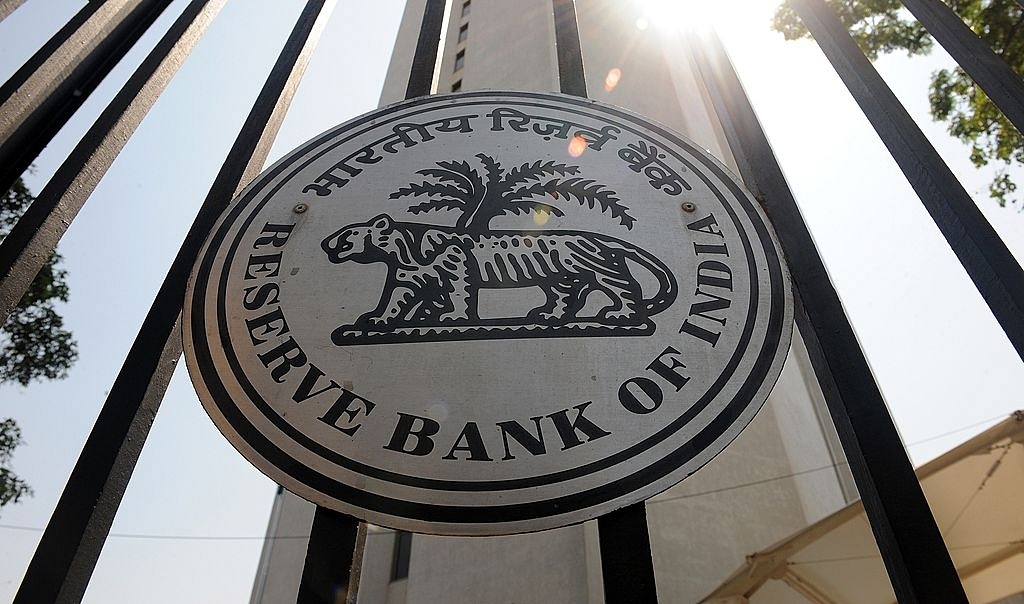Economy
MPC Has Misread Its Inflation Mandate; It Is Adding To The Economy’s Risks, Not Reducing Them
- What the MPC has demonstrated through it narrow focus on the inflation mandate is that it is risk-averse.
- In the process it has actually enhanced the risks in an economy struggling with low growth after receiving two successive shocks – demonetisation and the goods and services tax.

The Reserve Bank of India (RBI) logo on the main entrance gate of the RBI headquarters in Mumbai. (INDRANIL MUKHERJEE/AFP/Getty Images)
The Monetary Policy Committee’s (MPC’s) decision to keep the repo rate unchanged at 6 per cent shows that the economy is not going to get any help from the moneyman in pushing growth. The committee apparently sees no contradiction between its decision to bring down its growth estimates for 2017-18 by a sharp 0.6 per cent, from 7.3 per cent to 6.7 per cent, and maintaining rates where they are.
Throughout 2017, the MPC has been on its own trip. The waywardness started in February, when the MPC unexpectedly shifted its policy stance from “accommodative” to “neutral” just when demonetisation had already compressed demand and clipped growth. In June, despite sharply falling retail inflation, it refused to cut rates, thus displaying a high level of disconnect and disregard for the needs of the real economy. It’s latest policy thus comes as no surprise.
The MPC seems to have either misread the inflation mandate given to it by the government, or is misreading the signals coming from the economy, where the real sector is struggling to get growth rates up.
The MPC’s mandate is to target inflation in the range of 2-6 per cent, with 4 per cent being the middle rate. So, even with its current forecast of 4.2-4.6 per cent retail inflation in the second half of 2017-18, it hardly is in any danger of busting the mandate. It has huge leeway to cut rates, but it has chosen to sit on its hands.
Even assuming inflation suddenly soars due to food or fuel prices, the MPC has enough time to fulfil its mandate by making changes to rates. Under the agreement with the government for 2016-2021, it will be deemed to have failed only if “average inflation is more than the upper tolerance level of 4 per cent plus two per cent, that is six per cent, or the lower tolerance level of four per cent minus two per cent, that is two per cent, for any three consecutive quarters.” (Italics mine)
In other words, even assuming the MPC and the Reserve Bank of India (RBI) misjudged the trajectory of inflation, they have nine whole months to take corrective action. In this time, they can not only take policy actions, but also consult with the government to prompt the latter to take its own measures to fix supply problems, raise or lower taxes or tariffs, or provide a general stimulus, if needed.
The inflation mandate is thus flexible enough for the MPC to take some calculated risks to push growth, but this is exactly what the committee has not done.
The RBI’s role is that of a risk-manager, and it has to take calls based on its assessment of whether the inflation risk is greater than the risk of slowing growth. Right now it appears to be hidebound, focused excessively on only one part of its mandate, which is to keep inflation in check. It is ignoring the other part of its mandate, which is to help growth, especially when inflation is being driven by one-off factors.
This is how the explanatory part of the agreement between the Finance Ministry and the MPC is worded, complete with its inelegant grammar: “The key advantage of (having) a range around a target is that it allows the MPC to recognise the short run trade-offs between inflation and growth, but enables it to pursue the inflation target in the long run over the course of the business cycle. The range also accommodates data limitations, projection errors, short-run supply gaps and instability in agriculture production, an important factor for CPI inflation, as food articles have a major weight in the CPI indices. It also allows to accommodate unanticipated short-term shocks even while nudging public inflation expectations on the centre of the range, to which the monetary policy will return the economy over the medium term, leading to transparency and predictability.”
This wording implies that the MPC can take calculated risks in taking a call on rates, especially if the risks are short-term in nature, or there are temporary shocks to the system.
What the MPC has demonstrated through it narrow focus on the inflation mandate is that it is risk-averse. In the process it has actually enhanced the risks in an economy struggling with low growth after receiving two successive shocks – demonetisation and the goods and services tax.
Should the economy’s risk manager be adding to risks or reducing them?
Support Swarajya's 50 Ground Reports Project & Sponsor A Story
Every general election Swarajya does a 50 ground reports project.
Aimed only at serious readers and those who appreciate the nuances of political undercurrents, the project provides a sense of India's electoral landscape. As you know, these reports are produced after considerable investment of travel, time and effort on the ground.
This time too we've kicked off the project in style and have covered over 30 constituencies already. If you're someone who appreciates such work and have enjoyed our coverage please consider sponsoring a ground report for just Rs 2999 to Rs 19,999 - it goes a long way in helping us produce more quality reportage.
You can also back this project by becoming a subscriber for as little as Rs 999 - so do click on this links and choose a plan that suits you and back us.
Click below to contribute.
Latest